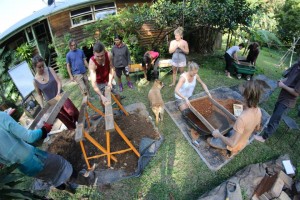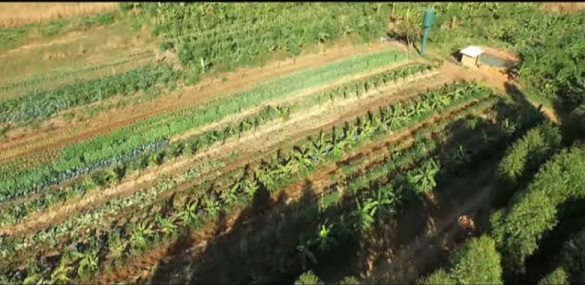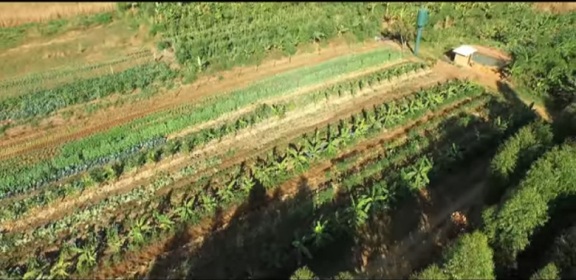-
Living and precious, the earth plays an essential role in our garden. So, before even thinking about planting, let's learn to listen to it, to enrich it and to protect it so that it gives the best of itself.
1) Preserve the ecosystem
Taking care of the soil is one of the fundamental principles of Permaculture Education that has revolutionized our approach to gardening. Yet the soil in our gardens has too often been neglected, abused and even poisoned by aggressive practices. Pesticides, weed killers, chemical fertilizers and deep ploughing end up taking all life away from these soils considered to be simple growing media. It is, therefore, our soil that must be taken care of as a priority, even before pampering the plants that it must nourish for Syntropic Gardening Queensland.

2) Learn to listen to it
Is your soil compact, sticking to your finger and hardening in summer? No doubt, it is clayey. To improve it, bring it manure and compost. It is light, does not form a cold and dries up quickly: it is sandy soil. It then requires organic matter or even a limestone amendment if it turns out to be too acidic. Your soil, on the other hand, is chalky, very dry in summer and muddy in winter: it is limestone.
Complete fertilizer and organic amendments (manure, potting soil, and humus) will be welcome for Permaculture Land Sale. If it is dark, easy to work and is full of water: it is acid earth. Improve drainage and add fertilizers rich in phosphorus and potash. T o find out more, perform a soil test to correct any deficiencies.
3) Understand its mechanisms
Bacteria in the soil fix the nitrogen essential for plant growth. Microscopic fungi help plants to absorb water and nutrients. Finally, earthworms and other soil animals dig tunnels that aerate and fertilize the earth. Hence the importance of the contributions of organic matter to the surface which will be buried by these little animals. So, in your vegetable garden, let unharvested vegetables and their tops decompose on the spot according to Syntropic Farming Community. In this case, you will no longer need to spike your vegetables with fertilizers since the earth has more than enough to feed them.
Finally, in order not to exhaust it unnecessarily and to avoid the appearance of diseases, respect the crop rotation. Wait four years before planting onions, cabbages or strawberries in the same place. Also, avoid replanting vegetables from the same family on the same plot for Syntropic Farming Queensland. Example: peas, lentils, beans of the Fabaceae family will not follow one another in the same location.
4) Torking smoothly
According to Permaculture Community digging your garden is bad for your back and especially for the earth. By turning it over, you upset the complex organizations of the microorganisms that make it live. To prepare your vegetable garden, go to the germinate. This garden fork, with three or five tines, aerates and loosens the soil gently. It is ecological and ergonomic.
The Permaculture Teacher taught us that to break up the surface crusts that suffocate the earth, just use a hoe. Likewise, avoid walking in your flower beds so as not to compact the wet soil.
 votre commentaire
votre commentaire
-
A 10-day Permaculture Course that will enhance the work being carried out. We invite you to live a deep experience of immersion in a life dedicated to going beyond sustainability and transforming our realities individually and collectively through the beautiful vision.

Topics to Work
- Permaculture Design
Analysis of the current reality
Principles of attitude
Natural Systems Guidelines
Community Soil Restoration
- Soil Seeding
Effective Microorganisms
Cold and Hot Composts
- Self-Sufficient Productive Systems
Herbs, Vegetables
Annual Cultivation
Food Forests
Community Seed Banks
- Wild Seed Collection Seed
Production
Selection, Storage
Who is this PDC for?
This transformative learning and society coexistence course determined on Permaculture Queensland. It is expected at people who are inquisitive to bring in themselves or get deeper in the growth and design of more logical and sustainable life models. It is a course that prepares you to experience a first immersion in very broad and diverse topics that propose new ways of living, so the course is aimed at all those people who do not feel comfortable with how society, the economy works, education, health, food, relationships, and in general the dynamics of a world that does not revolve in harmony with the natural flows of our nature.
You feel the call to do something different. You want to do something that must necessarily question the patterns and conditions that we have imposed as humanity and that direct us today towards separation and destruction. Then this Permaculture Course Australia can give new light to that transformation that we can carry out together.
COURSE LEARNING OBJECTIVES
- DESIGN: Practice techniques for observation and surveying; learn to read and make maps, select and use tools for site analysis and assessment. Integrate ethics, principles, and climate-specific strategies to create innovative design solutions, and experience several iterations of group design processes.
- CLIMATE AND LANDFORM: Adapt design strategies to climate patterns; observe, enhance, and create microclimates; adapt design to slope, elevation, orientation, and local weather patterns.
- WATER: Understand the natural water cycle and effects of human interventions. Use earthworks to harvest the rain, recharge depleted groundwater, and prevent erosion. Learn to use & reuse water responsibly, including gray water solutions, constructed wetlands, and acquaculture.
- SOIL: Understand the living and non-living aspects of soil, and how appropriate human management can maximize productivity and health of soils. Know strategies and practice techniques that build fertility and resilience of soil in different climates and at different scales of use.
- LIVING LANDSCAPE MANAGEMENT: Understand basics of ecology at Permaculture Australia: succession, nutrient cycling and energy flows, behaviour of complex systems. Select appropriate solutions for intensive and extensive landscapes; Understand benefits of multi-yield systems at different scales, including diversified gardens, agroforestry, agrosilvopastoral landscapes, and managed woodlands.
- SOCIAL & ECONOMIC APPLICATIONS: Under PDC Australia, you will understand appropriate technologies and techniques for sustainable human settlements & society. Including: natural building, energy-efficient house design, community & decision-making strategies, transition towns, ethical livelihood creation & micro business, solidarity/social economy, local/alternative currencies.
 votre commentaire
votre commentaire
-
Have you heard of Permaculture Education? It is a term that is heard more and more within the circles of people involved in sustainability and agriculture.
It would be important to clarify that Syntropic Gardening Queensland is indeed about organic agriculture, as many people tend to think, but it also goes much further than that.
Permaculture, in its most basic definition, is a science of DESIGN. It is a way of looking at the world and relating to it. The application of permaculture begins with yourself, with the design of your life and then the design of your home, your community, and ultimately, the entire world.
Permaculture is both the recognition of how unsustainable modern civilization is and at the same time it is the same map that guides us and prepares us for a different future, in which the world is no longer powered by fossil fuels.
Permaculture is based on a very simple and at the same time very deep idea. It is an idea that indigenous cultures innately understood (and understand) but that we in modernity and the “developed” world have forgotten: the best Permaculture Teacher that exists is Nature itself and our ability to create a better world, resides in our ability to study, learn, and imitate the patterns and relationships found in Nature.
Brief history of permaculture
The concept of permaculture was born in Australia (Tasmania) in the early 1970s; his two parents: Bill Molligan, professor and David Holmgren, university student. The word permaculture came from their discussions about how to create a system of “Permaculture Land Sale”, understanding how unsustainable conventional industrial agriculture was (and is). Then they changed perspective. They began to use the term "permaculture" in a broader sense to mean "permanent culture."

In other words, permaculture is a science that seeks to create ecologically sustainable and therefore permanent human settlements.
What are the topics and content of the course?
Introduction to Permaculture
It is Ethics, principles and methodology; observing patterns in nature as a design tool; Principle of design by zones and sectors, learning in action.
The environment: climate, soils and design practices
Microclimate, topography, soil types, mapping and graphic representation.
Bioconstruction
Bioclimatic design and materials in bio construction Syntropic Farming Community. Green and natural construction methods, design for climate and culture, site selection.
Renewable Energies and Appropriate Technologies Renewable energy
Strategies and appropriate technologies for heating, cooling, transportation, cooking, and construction, decrease.
Water management
The cycle and capture of water, Keyline design and natural tanks, cisterns and pools. Gray and black waters in the design of the system; aquaculture.
Agriculture and garden design in Permaculture.
Agroecology, garden design, compost, vermicompost, irrigation, planting schedules, seed bank, nendodango, pest management, integration of animals and insects, Syntropic Farming Queensland.
Edible forest or Forest Garden
Edible forests, analog forestry, permaculture forest design; hedges, windbreaks and protection strips. Identification of wild edible plants from local forests.
Permaculture application in the social Permaculture community
Ecovillages, community and human relations in Syntropic Gardening Queensland. Ecological ecology and law and local networks of social capital; Permaculture in education. Peoples in Transition. Deep Ecology. Health and nutrition. Next steps to put Permaculture into practice in your life. Group of project design presentations, show non-talent and the final party.
 votre commentaire
votre commentaire
-
The idea of Permaculture Education is to empower people to be self-sustainable and how people can make sure for themselves and not depend on someone or external issues to survive.

How can all live in greater harmony with the environment?
Permaculture Teacher gives you a guide to imitate the patterns and relationships that you find in nature that allows you a path to a more conscious life, a path to a more efficient design of your homes, harvesting your food, finding your place in a natural world, and more. Its purpose is not only to protect the environment, but also to use its wealth in a way that supports both current and future generations. Becoming a Certified Permaculture Designer is a great step in making a difference!
Short Term Course
It is a 10-day, certified course where several basic topics are touched on to have the bases to be a good Permaculture Community. Little by little and with practice and applications you will be able to deepen each year with courses, volunteers and / or advising you through network to care for the Earth, the people and to share kindly and in reciprocity.
Permaculture is a systemic design method that seeks to create sustainable and healthy settlements. It is a way of living creating environmental solutions in the world.
Its bases are found in the wisdom of the native territorial nations and in ecology.
Its design is based on replicating the natural patterns of life that have dynamically remained in balance with each other since its origins.
It is the conceptual basis of the eco-social change that humanity is experiencing today.
The concept was born in the late 70s in Australia and most of permaculture students have studied in permaculture centers that manage a certified curriculum created by international institutions.
Aimed at: All those people, with or without previous experience, who want to make a profound change in their lives and want to ally themselves with Nature in a large conscious, dynamic and transparent Syntropic Farming Community that walks a sustainable and healthy life from the individual plane, family, collective and territorial
Objectives
Teach to design according to the ethics and principles of Permaculture.
Internalize in the cycles and forces of nature, to learn to interact kindly and sustainably with them.
Expose different social paradigms from a critical and reflective position that helps us take the first steps to regain our autonomy guided by health and sustainability.
Syntropic Farming Queensland – Deliver practical tools, techniques within the domains of permaculture and / or the flower of permaculture.
Delve into a holistic and comprehensive theoretical framework.
Create community with a strong social fabric that encourages networking and networking.
Ethodology
Intensive 10-day theoretical-practical, face-to-face course, under the learning by doing modality with expository presentations, group work and design projects.
The information regarding the origin of the citation is in a separate text field, similar to the legends below, so that the structure of the citation is protected even if you select, modify or remove it from the origin. It is always easy to add it again.
 votre commentaire
votre commentaire
-
Do you know Permaculture Course?
This is an internationally recognized 95hrs course, offered worldwide as an introduction to humanity in more sustainable ways to build your civilizations and lives seeking greater harmony and joint work with nature, thus creating societies and a world with more peace!
The contents of the Permaculture Course are based on an official curriculum.
Who is it for?
This course is intended for students, teachers, parents, farmers and farmers, gardeners, projects and ecological businesses, architects, economists, societies, land owners and basically anyone who is interested in learning more about how-to live-in harmony with the nature and the world.

What does it mean to have this Permaculture Australia certification?
This certification opens doors for you worldwide as it is internationally recognized. The design certificate course is the first step in PDC Australia, which is recognized. However, permaculture training is based on years of design practice in the field, in real situations.
Upon completion of the Permaculture Queensland course, Participants who have attended a minimum of 80% of the sessions and the group design practice will receive an internationally recognized certificate of Permaculture Design, which will allow them to attend permaculture teacher training courses, access the diploma in applied permaculture and use the word permaculture in your design work for yourself and for others.
Why are these Permaculture Course Australia?
Experts believe that there is a great need to train the future leaders of your communities and cities to move you to the use of more sustainable practices in all aspects of your society user and more resident societies.
This course is a 14-day Intensive with two full days on Regenerative Agriculture.
In which the participants share not only classes, but activities, group dynamics, group design work, presentations, videos, talks, speeches, simulations and also here we share making meals together, creating community ties and mutual collaboration.
During the two days of Agriculture Regenerative you will learn techniques and practices of regeneration and treatment of soils, aquifers, the improvement of soil biology and how to holistically manage your land, animals and the economy of your farm or project, creating ties of benefit between the human, biological and economic components. This knowledge seems to you of great importance due to the current situation of imbalance between natural resources, your land and the economy of those who work the fields.
During this course you will work on many practices and exercises that are used in the design of ecovillages and communities, so that the participants learn to coordinate and take responsibility for leadership tasks and better communication between groups.
Institute wanted to offer a very solid course in content and practices so that the participants can be trained and create real permaculture projects that help ecology and improve the quality of life in general.
As explained all facts above reveals that this course is very useful to save nature. To register your name for the course visit website and fill the form. You will be enrolled.
 votre commentaire
votre commentaire Suivre le flux RSS des articles
Suivre le flux RSS des articles Suivre le flux RSS des commentaires
Suivre le flux RSS des commentaires


